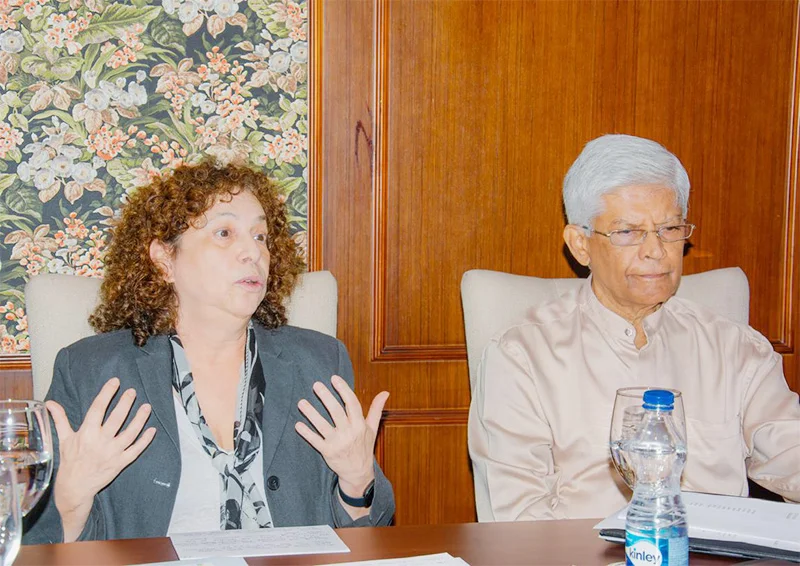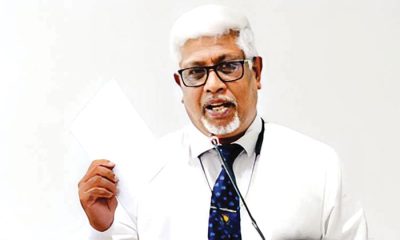Features
Patient-centred care and CKDu

Some observations on the occasion of World Kidney Day
By Prof. M.W. Amarasiri de Silva
(Inaugural Fellow, International Society of Nephrology 2018, Adjunct Professor at the University of Pittsburgh, USA, and Professor Emeritus, University of Peradeniya)
Today is World Kidney Day, and this year the principal focus is on patient-centred care for people living with kidney disease. This theme highlights the increasing recognition of the need to identify and address patients’ priorities, values, and goals in order to advance the research, practice, and policy designed to improve the quality of life of people suffering from chronic kidney disease. Regardless of the type of kidney disease or the approach to treatment adopted, patients want to live well, retain their social place, maintain some semblance of normality, and have a sense of control over their health and wellbeing.
A patient-centred approach is one where the patients are treated as social individuals and enabled to take control of and improve their health. Thus, they become active participants in their care. Their biology becomes secondary in this process. Members of patients’ families and communities can continue to focus on them as people, rather than on their illness or disability. Support should concentrate on achieving the patients’ aspirations and be tailored to their needs and unique circumstances.
A patient-centred approach to health requires building public policy, creating supportive environments, facilitating community action, and developing and improving patients’ skills and knowledge of disease management. Overall, any such programme requires a complete reorientation of the treatment system. Those who work directly with patients at the District Secretariat (DS) Division level – the public health inspectors, public health nurses, nurses, hospital attendants, community workers, health educators, rural development officers, childcare officers, and others – should be directed towards a patient-centred approach, and trained in good communication skills and to address patient needs effectively. A patient-centred approach should address those with chronic disease of unknown aetiology (CKDu) within their family and community, and become an integral part of everyday life in the family and community. If CKDu sufferers are uprooted from their social setting and placed in a clinic-based environment, the treatment system becomes an artificial one with no link to the patient’s cultural milieu. Such treatment systems do not work satisfactorily.
In western societies, community health workers, working in communities, facilitate this process by assisting the medical specialists in hospitals. They visit the homes of patients and help their families to overcome problems through counselling. In Sri Lanka, such a link between the community/family and the hospital, focusing on the patient, is missing. Especially with regards to CKDu patients, establishing a connection between the community and the hospital is crucial. Such a link would help to alleviate the stigma attached to CKDu patients in the community and the neglect and isolation that many have to endure. Visits by hospital staff and paramedics to patients in their homes can improve the understanding of hospital staff about how patients live at home, what problems do they face at home and in the community. It would improve the commitment of patients towards their treatment. This would also improve their compliance with their medical regimen. A change in the treatment procedures from a hospital-based system to a patient-centred one is necessary, as the existing approach has had little impact in assisting CKDu patients in addressing their grievances and improving their quality of life, or in reducing the incidence of and death rates from the disease.
In a patient-centred approach to the treatment and care of CKDu patients, essential elements are community engagement and empowerment. Educating the patients and their families on disease risk factors and treatments is a prerequisite. In Sri Lanka, government programmes have invested in developing people’s understanding of the risk factors for CKDu but have not paid much attention to improving people’s knowledge of treatments and testing procedures. Therefore, most people in CKDu-affected areas have knowledge of the causes of CKDu, but have limited understanding of treatments. As a result, patients are not able to make an informed decision on the type of treatment that they should undergo or to discuss the subject with their medical professionals. They blindly accept (or reject) the type of treatment recommended by the doctors.
In Sri Lanka, people’s knowledge of treatments for kidney disease is fragmentary. Their knowledge of things like blood transfusion is limited and is very hospital centred. Experience in other countries shows that patients on a home therapy or haemodialysis at home were more satisfied than those with in-centre haemodialysis. In Sri Lanka, haemodialysis at home has not been promoted.
Most CKDu patients undergo harrowing experiences in their communities and at home. They report a substantial drop in their quality of life. Their illness means that they cannot draw water from the dug well to wash or use the toilets with squatting pans. They are advised to install commodes in their toilets, but most CKDu patients cannot afford to do this. Many say that they cannot cultivate their rice paddy land, so they don’t get any income from agriculture. Although they are paid Rs. 5,000 by the government each month, that is not adequate for a family of five people to live an ordinary life. As CKDu patients find it difficult to use public transport, they have to hire a vehicle at a significant cost each time they visit the clinic. In many families, children have dropped out of school because their parents cannot afford to provide for their education. About 15% of CKDu patients in the villages live alone, with, in many cases, their wives having left them and gone to the Middle East for employment. Family members say that the CKDu patients have become demanding. Many CKDu patients and their family members display signs of depression and uneasiness.
Those patients on dialysis need to attend the clinic once every three days. Many patients do not attend the clinics as required due to financial difficulties. Each visit to the clinic requires Rs. 2,000 to 3,000 for transportation, which is beyond many patients’ means, and therefore, after a few visits, they drop out of the dialysis programme. A patient told me, ‘the doctor told me that I have to get a kidney transplant. I am on the waiting list like many thousands of patients. I have no great hopes anyway. I undergo blood transfusion. I was asked to come to the clinic every third day, but I don’t have money to pay for a vehicle every time. I mortgaged my two acres of rice paddy two years ago, and the money has been spent on my treatment and food for the family’.
A patient-centred approach should highlight how to improve the quality of life of CKDu patients and families. The quality of life for patients should become the dominant preoccupation in health promotion in CKDu communities. Essential health professionals, such as health educators, public health inspectors, and public health midwives, should take the lead in educating the CKDu-affected population about the management of patients at home and in their communities. They should discuss how behavioural changes could improve health, for example identifying the adverse effects of smoking and chewing tobacco. Referring to her husband, a CKDu patient, a woman said, ‘My husband smokes a lot. He smokes a bundle of beedi a day. One bundle of beedi is Rs. 100 and contains 25 beedis. He smokes them at night, early in the morning, and at work… However much I tell him to, he doesn’t stop’. Many patients do not regularly take the medication given by the clinic or attend their appointments as scheduled.
People surveyed during the course of my research were not very aware of the difference between CKD and CKDu. Most CKDu patients identified having diabetes and high blood pressure as risk factors for CKDu. They are risk factors for CKD, and CKDu develops due to other factors in the absence of diabetes and hypertension. Most end-stage patients did not know what treatment options were available for them, and preferred to stay and die at home. Compared to affluent families in the CKDu-affected communities, the paddy farmers who own less than two acres of rice paddy are less educated and lacking in CKDu-related health knowledge.
Any community empowerment programme, focusing on CKDu patients, should discuss the basics of kidney function, CKDu testing procedures, and the management of CKDu at home and in the community.
Recommendations:
A reorientation of the hospital-centred approach to a patient-centred one. This requires training local officers at the DS Division level. A programme for this has to be identified and discussed at ministerial level with the participation of Community Based Organisations in the area, patients, carers, medical and paramedical practitioners. A sociologist/anthropologist working in the area of community empowerment and participation would also be an asset.
The introduction of home dialysis should be considered as a measure to enhance the community/family role in CKDu disease management. Home dialysis needs a cleanroom, which is hard to find in farmer households in CKDu-endemic areas. Therefore, for each Grama Niladhari Division, the government should consider building a spacious room in a central location and constructing all the facilities for patients to come and undergo dialysis. A community member should be trained to handle the procedures.
To effectively address the increasing incidence of CKDu in the epidemic regions in Sri Lanka, a well-developed intervention and a community education programme, focusing on behavioural change, should be aimed at lower socioeconomic groups.
The government should strengthen the patient-centred approach to treatment and care. Although medical education programmes in the universities prioritize medical professionals’ role in treatment, patient-centred approaches are seldom discussed. The universities should focus on CKDu-affected districts when selecting villages for students’ intervention and training on a patient-centred approach. Departments of Community Medicine should take the lead in this direction.
A programme to address depression among CKDu patients, needs to be established. DS Division level officers appointed for community work should be trained to handle the psychological issues afflicting CKDu patients. The education and counselling of end-stage kidney patients are essential as many such people have refused to undergo dialysis or kidney transplants.
The basics of kidney function and the risk factors for CKDu should be taught to school pupils in areas where CKDu is endemic.
Features
SL urged to use GSP+ to the fullest to promote export development

 Sri Lanka needs to take full stock of its current economic situation and use to the maximum the potential in its GSP+ facility for export sector growth. In the process, it should ensure that it cooperates fully with the European Union. The urgency of undertaking these responsibilities is underscored by the issues growing out of the recent US decision to sweepingly hike tariffs on its imports, though differentially.
Sri Lanka needs to take full stock of its current economic situation and use to the maximum the potential in its GSP+ facility for export sector growth. In the process, it should ensure that it cooperates fully with the European Union. The urgency of undertaking these responsibilities is underscored by the issues growing out of the recent US decision to sweepingly hike tariffs on its imports, though differentially.
These were principal ‘takes’ for participants in the Pathfinder Foundation’s Ambassadors’ Roundtable forum held on April 8th at the Colombo Club of the Taj Samudra. The main presenter at the event was Ms. Carmen Moreno Raymundo, Ambassador of the European Union to Sri Lanka and the Maldives. The forum was chaired by Ambassador Bernard Goonetilleke, Chairman, Pathfinder Foundation. The event brought together a cross-section of the local public, including the media.
Ms. Moreno drew attention to the fact Sri Lanka is at present severely under utilizing its GSP+ facility, which is the main means for Sri Lanka to enter the very vast EU market of 450 million people. In fact the EU has been Sri Lanka’s biggest trading partner. In 2023, for instance, total trade between the partners stood at Euros 3.84 billion. There is no greater market but the EU region for Sri Lanka.
‘However, only Sri Lanka’s apparel sector has seen considerable growth over the years. It is the only export sector in Sri Lanka which could be said to be fully developed. However, wider ranging export growth is possible provided Sri Lanka exploits to the fullest the opportunities presented by GSP+.’
Moreno added, among other things: ‘Sri Lanka is one among only eight countries that have been granted the EU’s GSP+ facility. The wide-ranging export possibilities opened by the facility are waiting to be utilized. In the process, the country needs to participate in world trade in a dynamic way. It cannot opt for a closed economy. As long as economic vibrancy remains unachieved, Sri Lanka cannot enter into world trading arrangements from a strong position. Among other things, Sri Lanka must access the tools that will enable it to spot and make full use of export opportunities.
‘Sri Lanka must facilitate the private sector in a major way and make it possible for foreign investors to enter the local economy with no hassle and compete for local business opportunities unfettered. At present, Lanka lacks the relevant legal framework to make all this happen satisfactorily.
‘Sri Lanka cannot opt for what could be seen as opaque arrangements with bilateral economic partners. Transparency must be made to prevail in its dealings with investors and other relevant quarters. It’s the public good that must be ensured. The EU would like to see the local economy further opening up for foreign investment.
‘However, it is important that Sri Lanka cooperates with the EU in the latter’s efforts to bring about beneficial outcomes for Sri Lankans. Cooperation could be ensured by Sri Lanka fully abiding by the EU conditions that are attendant on the granting of GSP+. There are, for example, a number of commitments and international conventions that Sri Lanka signed up to and had promised to implement on its receipt of GSP+ which have hitherto not been complied with. Some of these relate to human rights and labour regulations.
‘Successive governments have pledged to implement these conventions but thus far nothing has happened by way of compliance. GSP+ must be seen as an opportunity and not a threat and by complying with EU conditions the best fruits could be reaped from GSP+. It is relevant to remember that GSP+ was granted to Sri Lanka in 2005. It was suspended five years later and restored in 2017.
‘The importance of compliance with EU conditions is greatly enhanced at present in view of the fact that Sri Lanka is currently being monitored by the EU with regard to compliance ahead of extending GSP+ next year. A report on Sri Lanka is due next year wherein the country’s performance with regard to cooperating with the EU would be assessed. The continuation of the facility depends on the degree of cooperation.
‘A few statistics would bear out the importance of Sri Lanka’s partnership with the EU. For example, under the facility Sri Lanka benefits from duty free access in over 66% of EU tariff lines. The highest number of tourist arrivals in Sri Lanka in 2023 was from the EU’s 27 member states. Likewise, the EU’s 27 member states rank second in the origin of inflows of foreign exchange to Sri Lanka; with Italy, France and Germany figuring as the main countries of origin. Eighty five percent of Sri Lanka’s exports to the EU market benefits from GSP+. Thus, the stakes for the country are high.’
Meanwhile, President, In-house Counsel & Legal Advisor, The European Chamber of Commerce of Sri Lanka, John Wilson said: ‘GSP+ should be seen as not only an opportunity but also as a necessity by Sri Lanka in the current international economic climate. ‘Implementation of local laws is what is needed. Considering the pressures growing out of the US imposed new tariff regime, a good dialogue with the EU is needed.
‘Sri Lanka’s level of business readiness must be upped. Among the imperatives are: An electronic procurement process, Customs reforms, a ‘National Single Window’, stepped-up access to land by investors, for example, a clear policy framework on PPPs and reform of the work permits system.’
It ought to be plain to see from the foregoing that Sri Lanka cannot afford to lose the GSP+ facility if it is stepped-up economic growth that is aimed at. It would be in Sri Lanka’s best interests to remain linked with the EU, considering the aggravated material hardships that could come in the wake of the imposition of the US’ new tariff regime. Sri Lanka would need to remain in a dialogue process with the EU, voice its reservations on matters growing out of GSP+, if any, iron out differences and ensure that its national interest is secured.
Features
SENSITIVE AND PASSIONATE…

Chit-Chat
Chiara Tissera
Mrs. Queen of the World Sri Lanka 2024, Chiara Tissera, leaves for the finals, in the USA, next month
I had a very interesting chat with her and this is how it all went:
1. How would you describe yourself?
I am a sensitive and passionate individual who deeply cares about the things that matter most to me. I approach life with a heart full of enthusiasm and a desire to make meaningful connections.
2. If you could change one thing about yourself, what would it be?
Actually, I wouldn’t change a thing about myself because the person I am today, both inside and out, is the result of everything I’ve experienced. Every part of me has shaped who I am, so I embrace both my strengths and imperfections as they make me uniquely me.
3. If you could change one thing about your family, what would it be?
If there’s one thing I could change about my family, it would be having my father back with us. Losing him six years ago left a void that can never be filled, but his memory continues to guide and inspire us every day.
4. School?
I went to St. Jude’s College, Kurana, and I’m really proud to say that the lessons I gained during my time there have shaped who I am today. My school and teachers instilled in me values of hard work, perseverance and the importance of community, and I carry those lessons with me every day. I was a senior prefect and was selected the Deputy Head Prefect of our college during my tenure.
5. Happiest moment?
The happiest moment of my life so far has been winning the Mrs. Sri Lanka 2024 for Queen of the World. It was a dream come true and a truly unforgettable experience, one that fills me with pride and gratitude every time I reflect on it.
6. What is your idea of perfect happiness?
Happiness is a deeply personal and multifaceted feeling that often comes from a sense of contentment, fulfillment and well-being. For me, perfect happiness is in moments of joy, peace and accomplishments … and also being surrounded by my loved ones.
7. Are you religious?
Yes, I’m a very religious person. And I’m a firm believer in God. My faith guides me through life, providing strength, dedication and a sense of peace in every situation. I live by the quote, ‘Do your best, and God will do the rest.’
8. Are you superstitious?
I’m not superstitious. I believe in making my own decisions and relying on logic and faith rather than following superstitions.
9. Your ideal guy?
My ideal guy is my husband. He is compassionate, understanding and is always there to support me, no matter what. He’s my rock and my best friend – truly everything I could ever want in a partner.
10. Which living person do you most admire?
The living person I admire the most is definitely my mummy. Her strength, love and unwavering support has shaped me into who I am today. She is my role model and she inspires me every day with her wisdom and kindness.
11. Your most treasured possession?
My most treasured possession is my family. They are the heart of my life, providing me with love, support and strength. Their presence is my greatest blessing.
12. If you were marooned on a desert island, who would you like as your companion?
I would like to have my spouse as my companion. Together, we could make the best of the situation, supporting each other, sharing moments of laughter and finding creative ways to survive and thrive.
13. Your most embarrassing moment?
There’s quite a few, for sure, but nothing is really coming to mind right now.
14. Done anything daring?
Yes, stepping out of my comfort zone and taking part in a pageant. I had no experience and was nervous about putting myself out there, but I decided to challenge myself and go for it. It pushed me to grow in so many ways—learning to embrace confidence, handle pressure, and appreciate my own uniqueness. The experience not only boosted my self-esteem but also taught me the value of taking risks and embracing new opportunities, even when they feel intimidating.”
15. Your ideal vacation?
It would be to Paris. The city has such a magical vibe and, of course, exploring the magical Eiffel Tower is in my bucket list. Especially the city being a mix of history culture and modern life in a way that feels timeless, I find it to be the ideal vacation spot for me.
16. What kind of music are you into?
I love romantic songs. I’m drawn to its emotional depth and the way they express love, longing a connection. Whether it’s a slow ballad, a classic love song or a more modern romantic tune these songs speak to my heart.
17. Favourite radio station?
I don’t have a specific radio station that I like, but I tend to enjoy a variety of stations, depending on my mood. Sometimes I’ll tune into one for a mix of popular hits, other times I might go for something more relaxing, or a station with a certain vibe. So I just like to keep it flexible and switch it up.
18. Favourite TV station?
I hardly find the time to sit down and watch TV. But, whenever I do find a little spare time, I tend to do some spontaneous binge – watching, catching whatever interesting show is on at that moment.
19 What would you like to be born as in your next life?
Mmmm, I’ve actually not thought about it, but I’d love to be born as someone who gets to explore the world freely – perhaps a bird soaring across continents.
20. Any major plans for the future?
Let’s say preparing and participating in the international pageant happening in the USA this May. It’s an exciting opportunity to represent myself and my country on a global stage. Alongside this, I am dedicated to continuing my social service work as a title holder, striving to make a meaningful difference in the lives of others through my platform.
Features
Fresher looking skin …

 The formation of wrinkles and fine lines is part of our ageing process. However, if these wrinkles negatively impact appearance, making one look older than they actually are, then trying out some homemade remedies, I’ve listed for you, this week, may help in giving your skin a fresher look.
The formation of wrinkles and fine lines is part of our ageing process. However, if these wrinkles negatively impact appearance, making one look older than they actually are, then trying out some homemade remedies, I’ve listed for you, this week, may help in giving your skin a fresher look.
* Banana:
Bananas are considered to be our skin’s best friend. They contain natural oils and vitamins that work very perfectly to boost our skin health. Skincare experts recommend applying the banana paste to the skin.
Take a ripe banana and mash a quarter of it until it becomes a smooth paste. Apply a thin layer of the banana paste on your skin and allow it to sit for 15 to 20 minutes before washing it off with warm water.
* Olive Oil:
Olive oil works as a great skin protector and many types of research suggest that even consuming olive oil may protect the skin from developing more wrinkles. Olive oil contains compounds that can increase the skin’s collagen levels. Yes, olive oil can be used as a dressing on your salads, or other food, if you want to consume it, otherwise, you can apply a thin layer of olive oil on your face, neck and hands and let it stay overnight.
* Ginger:
Ginger serves to be a brilliant anti-wrinkle remedy because of the high content of antioxidants in it. Ginger helps in breaking down elastin, which is one of the main reasons for wrinkles. You can have ginger tea or grate ginger and have it with honey, on a regular basis.
* Aloe Vera:
The malic acid present in Aloe Vera helps in improving your skin’s elasticity, which helps in reducing your wrinkles. Apply the gel once you extract it from the plant, and leave it on for 15-20 minutes. You can wash it off with warm water.
* Lemons:
Lemons contain citric acid, which is a strong exfoliant that can help you get rid of your dead skin cells and wrinkles. Also, as an astringent and a cleansing agent, it helps to fade your wrinkles and fine lines. You can gently rub a lemon slice in your wrinkled skin and leave it on for 10-15 minutes. Rinse afterwards and repeat this process two to three times a day.
* Coconut Oil:
Coconut oil contains essential fatty acid that moisturises the skin and helps to retain its elasticity. You can directly apply the coconut oil, and leave it overnight, after gently massaging it, for the best results.
-

 Business3 days ago
Business3 days agoColombo Coffee wins coveted management awards
-

 Business5 days ago
Business5 days agoDaraz Sri Lanka ushers in the New Year with 4.4 Avurudu Wasi Pro Max – Sri Lanka’s biggest online Avurudu sale
-

 Features4 days ago
Features4 days agoStarlink in the Global South
-

 Business6 days ago
Business6 days agoStrengthening SDG integration into provincial planning and development process
-

 Business5 days ago
Business5 days agoNew SL Sovereign Bonds win foreign investor confidence
-

 Features1 day ago
Features1 day agoSri Lanka’s Foreign Policy amid Geopolitical Transformations: 1990-2024 – Part III
-

 Features4 days ago
Features4 days agoModi’s Sri Lanka Sojourn
-

 Midweek Review1 day ago
Midweek Review1 day agoInequality is killing the Middle Class




















